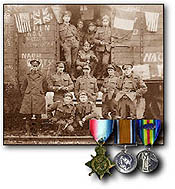Among the attestation records of the Canadian Expeditionary Force held
at the National Archives of Canada, there are 135 records which relate
to Pilons (1 is actually a Pillon). At first glance this appears
to be a large number of Pilons, however, it is important to note that following
the passing of the Conscription Act of 1917, individuals were drafted and
attestation records were actually opened and serial numbers assigned before
the individual had actually shown up to enlist on the day and at the place
indicated on the draft notice. Consequently, of the 135 attestation
records examined, 46 (34%) contained no information about the individuals
or the individuals never completed the enlistment process (they may have
shown up for their medical examinations, but they never returned to actually
enlist). The usual process allowed a 20 day waiting period, after
which the individual was declared a deserter. While a general amnesty
was declared for deserters after the war had ended, those apprehended during
the war faced severe penalties. In one instance, the individual was
sentenced to 6 months of hard labour.
From this point onwards, the analysis will deal only with the remaining
89 individuals who enlisted and served in the Canadian Expeditionary Force
during the First World War. A most important point to make before
any other information is considered, is the fact that of the 89 CEF members,
one was a woman, Nursing Sister Exaurée Pilon, one of a small handful
of Nursing Sisters who dedicated themselves to helping tend to the injured
Canadians on the battlefields of Europe. She served with distinction, enlisting
in March of 1915. She was finally demobilized in March of 1919, having
spent most of her time in hospitals in France. She even received a decoration
from the French government in 1920 for her service, the "Médaille
des Épidémies en Argent" (click
here to learn more about the Nursing Sisters of WWI).
|



